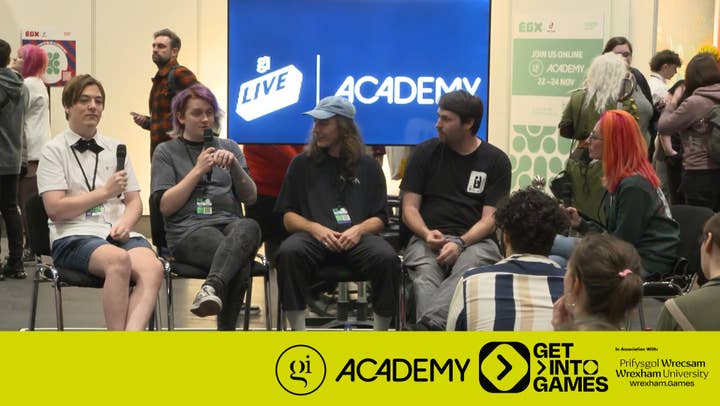Technical art roles: What they are, and how to get one
A panel of experts from Radical Forge discuss the potenital routes into this discipline and how to improve your chances of landing a role
This article is part of our Get into Games special, offering students insight on life in the games industry and advice on how to get into the business. You can also find aselection of the best Academy guides for job-seekers here
Of the myriad roles available in the games industry, an artist is perhaps one of the easiest positions for outsiders to understand. Programmers, too, do pretty much what they say on the tin. But technical artists? The people who span both those worlds and build the tools to turn art into fully realised assets and characters in video games? Well, that's a little more complicated.
During an EGX 2023 talk, the technical art team at Radical Forge – including Calvin Simpson (former principal technical artist, now CEO of Blueshift Interactive), Anthony Marmont (senior tools engineer), and Piotr Sidorowicz (junior technical artist) – joined CEO Bruce Slater and Liquid Crimson's head of comms, Lauran Carter, to explain exactly what technical artistry is, and how budding developers can forge a career in it.
- What is a technical artist?
- What's my first step to getting a technical artist role in the games industry?
- What are studios looking for when hiring a new technical artist?
- What coding languages should I prioritize learning?
- The number of recent layoffs has been really concerning. How can game developers protect themselves against redundancies?
What is a technical artist?
According to CEO Slater, who started out as a technical artist, there are two types of technical art:
Front end: visual effects and shaders ("making art look good," as he put it)
Back end: Tool tech and pipeline management (or "getting art into the game" and "making sure that the workflow to get things from A to B is efficient").
Interestingly, Slater said that even within these two different types of technical art roles, there are "a lot of sub-sectors", too, so what one tech artist does can vary wildly from another, not just in a different studio, but even inside the very same company.
What's my first step to getting a technical artist role in the games industry?
Sidorowicz started as a 3D artist and now works as a 'front end' technical artist with shaders and effects following a serendipitous meeting with CEO Slater when skateboarding. Their experience with modelling "was a good foot in the door" when it came to landing the role.

"It's a very good foundation to have," Sidorowicz said. "You can come from a programming background or an art background, and for me, it was art. Once you model, that's one step closer towards it."
And there are plenty of ways and opportunities to learn those skills, too. As Simpson pointed out, there are now significantly more university courses teaching more granular game design degrees than ever before, and people looking to get into the industry have considerably more access to industry tools and programs than budding devs had ten or 15 years ago. Consequently, prospective technical artists can hail from "pretty much any background," but "ultimately, it's just about picking something that you enjoy."
"If you're passionate about something – no matter which role you can get to – I think personality can sometimes take you further than skills because you can always learn skills," Simpson said.
CEO Slater agreed, adding that everyone on the panel who works at Radical Forge "has passion" as well as being "incredibly good at their jobs".
"We're very lucky to have them in the studio. But it is passion. It is complete passion, and [Sidorowicz] found technical art through passion."
Not that that should be a reason to let people exploit or take advantage of your passion, of course, and all panelists agreed that in the games industry, you have to be willing to "work your way up." However, even the jobs you don't enjoy are learning experiences, even if you "won't always get to work on what you want to work on."
"Though there are certainly those gigs out there that are pain, ultimately, everything is learning," Carter added. "So even if you find yourself in a studio and a month in, you realise these guys don't have the same motivations as you, and you're not seeing eye to eye? Take as much as you possibly can from that situation and work out what wasn't working and why."
Senior tools engineer Marmont, on the other hand, found technical artistry after discovering a love of tool-making when they worked in the indie space.
"The reason I'm on this tech art panel is really just because I kept on making tools," they explained. "I was going to studios, and I would make tools as a gameplay programmer. I would make tools as a server programmer. And then I got my job where I was actually just making tools full-time.
"If you do have that passion, it will show in your portfolio," they added, "And I think technical art is a really good skill to have when you are developing that portfolio. It was really beneficial for me to develop a style for my work, and technical art was really helpful. I love voxel art, I love pixel art, and doing that in some of my personal projects made my portfolio really nice and consistent, and you could understand what the gameplay systems were doing behind the scenes."
What are studios looking for when hiring a new technical artist?
For a studio like Radical Forge, the most important things it's looking for is a solid portfolio and a demonstrable passion for game design.
The panel also recommends that:
Your portfolio should only contain a handful of your very best pieces; and
You need to demonstrate how you make a mechanic or piece of technical art work.

Slater said what he would be looking for depends entirely on whether it's a front- or back-end position. Ensuring that someone can fit into the team is as important as their portfolio, too – that's why Radical Forge includes members of the team the new recruit will be working within the hiring process. And again, Slater said at this stage, he'd be looking for someone who can prove their passion for the role and games development more generally rather than just technical brilliance.
"We can teach anyone anything if they wanna learn it," Slater explained.
He added that the portfolio needs to not only demonstrate your final work, but also how you achieved it.
"I'd want to see how you made a certain mechanic work in real-time," Slater said by way of example. "I don't want to see just the mechanic or the art – I want to see the breakdown of how you did it. And I only need to see one of those things, I don't need to see 200! I only ever want to see your best work. So anything that's on your portfolio that isn't as good as the thing you did last week? Nuke it. Get rid of it. Because you will only be judged on your worst work."
When Marmont got their first game development position, they went to the studio with a tool they'd designed themselves and showed it to the designers.
"When developers and designers get their hands on a new tool, they're always so giddy with excitement," they said. "They're like, 'Oh my God! What can I do with this?' And that was when I knew I got the job.
"And that's something that happens to me in my day-to-day job now. I share my tools with [CEO Slater], and he's like, 'I can't wait to use this!'"
What coding languages should I prioritize learning?
As Simpson's very first role in development was directly in technical art, they recommend learning some coding for "a massive leg up" when it comes to beating the competition.
"Look into Python or Blueprints. A lot more projects these days use Unreal, so Blueprints is definitely a good shout. Those would definitely give you a good leg up. Some people might suggest C++, but I would probably say that would be more of an advanced thing that I would never expect from a junior technical artist," they added.
"But if coding is not your thing, then VFX is another good route because that is a subset of technical art. And you could just go straight into making particle effects, making shaders – that's a really good route as well. [There's also the] lighting side, another subset, but honestly, I've never really seen a 'junior' lighting artist! So just focus on the more technical parts of the art production pipeline."
How can game developers protect themselves against the current wave of redundancies?
Carter observed that when things like widespread layoffs happen, they can often feel a lot bigger to those directly in that field.
"But it doesn't happen all of the time," Carter said. "And then when it does happen – and especially when it happens in succession, which is what we've seen lately – it can be a little bit jarring."
Having been in the industry for 15 years, though, Carter said they've worked at three studios that have been shut down, but that hasn't held them back nor put them off working in the games industry at all.
"It's not dulled my absolute excitement to be involved in games," they explained. "It's one of the things that happens – the kind of natural ebb and flow that you get, anyway – and everything is hinging on a project launching. And if that project launches and it doesn't see the success that the 'money people' were expecting to see, then you're going to see things ever so slightly be shaved down.
"But those people are still going to be super passionate about the industry. They still want to do the jobs that they've learned how to do for however long. And that feeds the industry with new studios and new IP, and diversity of thought in the games industry is something that we really, really value."
Carter said that the games industry is one where there are "many people" – "inside and outside of your studio" – who will want to help and find laid-off devs find their next job.
"You'll never be left adrift. Essentially, they'll always be somewhere and someone to look after you."
More GamesIndustry.biz Academy guides to technical art
This article is part of our Get into Games special. You can find more talks and panels via the video links here, and a selection of the best Academy guides for job-seekers here.


